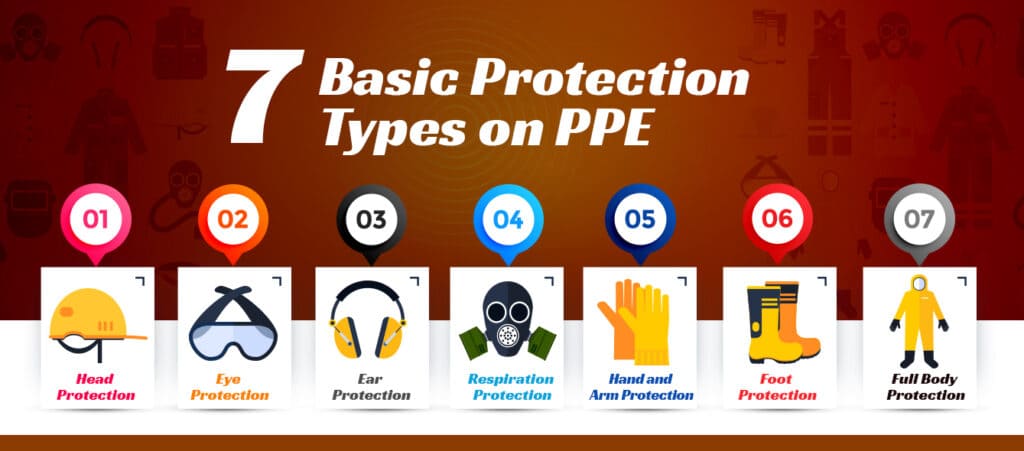
7 Basic Protection Types on PPE

PPE – Personal Protective Equipment:
Personal protective equipment is designed to protect the user or wearer from health and safety risks caused at the workplace. The injuries may occur to a person in contact with chemical, physical, electrical, mechanical, or other workplace hazards. Each PPE has a specific use, and it is made of specialized materials. PPE includes safety helmets, gloves, eyeglasses, earplugs, full-body suits, vests, hard hats, safety footwear, and Respiratory protective equipment (RPE).
7 Basic Protection Types on PPE
1. Head Protection:
- Head protection is needed to protect the scalp area. PPE includes Safety helmets and hard hats to protect the workers against heavy materials falling from a height or swinging objects in the workplace.
- Head protection is highly required while performing the task in construction, building repair, work in excavation or tunnels, and driving motorbikes.
2. Eye protection:
- Usually, workplace surroundings are filled with dust, gases, fumes, and mists, where PPE includes several eye-protection methods such as Safety spectacles, Eye shield, Safety goggles, and Face shields to protect your eyes from loss of vision, sprays of toxic liquids, splashes, and burns.
- Face shields are heavier than other equipment, but they protect your face and do not enclose your eyes.
3. Ear Protection:
- Hearing loss may occur to anyone working in noisy surroundings above the exposure action level. PPE like Earmuffs or defenders, Ear plugs, and canal Caps protect workers from severe ear damage.
- Earmuffs cover the ear, earplugs are inserted inside the ear canal, and the canal caps cover the outer part of the ear, ultimately protecting your ears and reducing risk.
4. Hand and Arm Protection:
- While working, handling sharp objects, vibrating equipment, Chemical substances can cause hand cuts, fractures, skin burns, and absorption of harmful substances.
- PPE includes hand protection like safety gloves, gauntlets, and Wrist cuff armlets to avoid hand injuries.
5. Foot Protection:
- Leg injuries may occur from falling or rolling objects, hot substances, electrical hazards, and slippery surfaces.
- Using PPE like Knee pads, Safety boots protect workers where the risk of heavy objects falling on their feet in the workplace.
6. Full-body Protection:
- The injuries may occur to workers from extreme temperatures, flames and sparks, toxic chemicals, insect bites, and radiation.
- Wearing proper PPE like life jackets, trousers, vests, clothing for hot, cold, or bad weather, and clothing for handling machinery covers your body and protect against injuries.
7. Respiration protection:
- The harmful gases, chemicals, and particle-droplets splashes which contain viruses and bacteria cause human inhalation.
- RPE includes full-face respirators, gas masks, N95 respirators, and self-contained breathing apparatus to protect workers from serious health injuries.
Importance of PPE Training to Employees:
- PPE plays a vital role in risk control measures, where the Organization’s role is to give proper safety training to employees on PPE to improve the hazard control events at the workplace.
- This training helps the employee to use personal protective equipment effectively and safeguard themselves while performing risker actions in the workplace.
- It helps to improve employee confidence and satisfaction while working and ensures a positive working environment.
Build your PPE training Program with Green World Group:
Safety training are nowadays recognized as an Industrial necessity. Green World Group is a leading HSE training and consulting service provider, offers a wide selection of global health and safety courses in virtual/live training. Industries usually prefer trained safety experts; Our professional experts help our clients to learn comprehensive knowledge on handling health and safety issues in the workplace.

 NEBOSH CERTIFICATE
NEBOSH CERTIFICATE NEBOSH DIPLOMA
NEBOSH DIPLOMA IOSH
IOSH SAFETY DIPLOMA
SAFETY DIPLOMA CPD UK
CPD UK ROSPA UK
ROSPA UK FOOD SAFETY
FOOD SAFETY 



